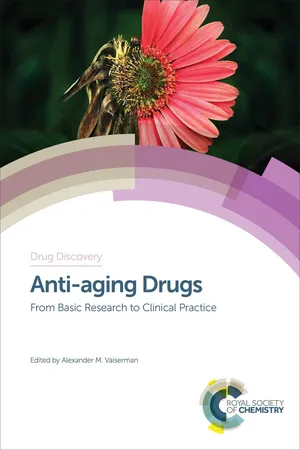10.1Introduction
Caloric restriction or calorie restriction (CR) is a relatively old concept, initially based on the data of McCay and colleagues.1 It was found that dietary-restricted rats lived longer than the corresponding controls.1 It was generally accepted for a long time that total amount of calories in consumed food did influence the life span of tested animals.2,3 After a while, life span extension by CR was observed for many model organisms, including fruit flies and nematodes.3 However, it was difficult to draw a distinct line between malnutrition and life span-prolonging CR. The mechanism of life span extension by limitation of ingested food was obscure. Hence, it is not distinguished whether food restriction improves some health parameters or overeating worsens them. In other words, an optimal caloric state was not set. On the one hand, a calorically restricted diet can be optimal for an organism while increasing the amount of food will worsen health and shorten life span.2,4 On the other hand, a “zero” point for amount of food consumed can be located between a supposedly “calorically restricted” diet and a diet promoting over-nutrition. It was found in the 2000s (Figure 10.1) that not only calories but particular nutrients, namely proteins, may play a role in determining life span.3,5–9 So, isocaloric diets with different amounts of proteins may result in different life spans of model organisms.3,9 At nearly the same time, the life-prolonging effects of resveratrol, a low molecular phenolic compound, were discovered.10 It was first noticed that resveratrol mimics CR.11,12 The molecular mechanisms of resveratrol were found to be mediated by NAD+-dependent histone deacetylases, sirtuins.11,13–15 Parallels between the life-extending effect and mimicking physiological and molecular signs of CR were found for many anti-aging drugs, including glitazones16 and rapamycin.17 Simultaneously, a number of compounds that block catabolism of macronutrients or even ingestion were found to provide life span prolongation.18 For instance, acarbose and 2-deoxyglucose, which block glycogen breakdown and glycolysis, respectively, are among these compounds.18 It is suggested that some CR mimetics are not only inhibitors of catabolism but are signaling molecules shamming energy and/or nutrient sensors of cells. Indeed, a way of blockage of nutrient delivery to cells may not matter. The result is always either a lack of energy in the form of adenosine triphosphate (ATP) or deficiency of some building blocks for synthesis of proteins, polysaccharides and lipids. The question about the superiority of energy over plastic material or vice versa is still unresolved. In addition, it is still not clear whether we should take into account the number of calories in the diet, or dietary composition, or macronutrient balance, or even certain dietary components, which when taken away from the diet would provide life span extension. In this review we will try to provide a comprehensive picture for development of the CR concept, the tissue-specific and intracellular consequences of CR, a description of drugs that mimic CR outcomes, and suggest a mechanism explaining why a decrease in either energy or specific nutrients may lead to an increased life expectancy in particular biological species.
Figure 10.1Development of CR concept and related findings. Data were obtained from Masoro.19 The figure is modified from Benjamin et al.20 Briefly, the first book on CR collected data on the effects of CR on organismal life span and was published in 1988. Until the mid-1990s, the life-prolonging effects of CR had been proven for main classes of the Animalia kingdom, including humans. Since the mid-1990s, several other concepts have been overlapping with the CR concept (e.g., the hypothesis of methionine restriction). The first compound that prolongs life span by mimicking CR, resveratrol, was discovered in 2003. In each box: in black font: surname(s) of the investigator(s); in blue font: either model organism tested, or experiment mode, or key finding.
10.2Aging and CR
The first evidence on the ability of CR to extend life span came from experiments performed in rats by McCay and colleagues.1 Further studies showed that CR extended the life span by shifting mortality factors, such as diseases and tumors, to older age. Using different protocols, researchers revealed the life span extension by CR in many organisms like yeast, rotifers, spiders, nematodes, flies, fishes and mammals, including non-human primates (Figure 10.1).
10.2.1CR in Yeast: Saccharomyces cerevisiae
Replicative and chronological life spans are described for unicellular yeast. The replicative life span is measured by the amount of formed daughter cells produced by a single cell. Reduction of the glucose concentration from 2% to 0.5% was the first CR intervention in yeast and this extended the replicative life span two-fold. The same study showed the importance of certain genes (SIR2, FOB1, CYT1) for mediating this phenotype. In addition, gene expression profiles of mutants with overexpression of HXK2 and HAP4 showed significant overlap with CR-treated cells. A similar protocol was used in later studies to show the importance of the TOR pathway and transcription factors Msn2 and Msn4 in mediating life span extension by CR. In addition, many genes and factors were identified in yeast as important regulators of life span. The life-extending properties of many drugs, remedies and natural extracts were later discovered using this method.21–23
Chronological life span is also described for unicellular organisms such as yeast Saccharomyces cerevisiae. Determination of chronological life span requires a measurement of the number of alive cells able to produce colonies while transferred to fresh media over different time points.24 Cells are quiescent in the G0 phase of the cell cycle but are metabolically active thus having some similarities to those of postmitotic tissues in adult multicellular organisms. Taking into account the similarities of basic biochemical pathways in yeast and other organisms, the model of yeast replicative and chronological life spans can be success...

